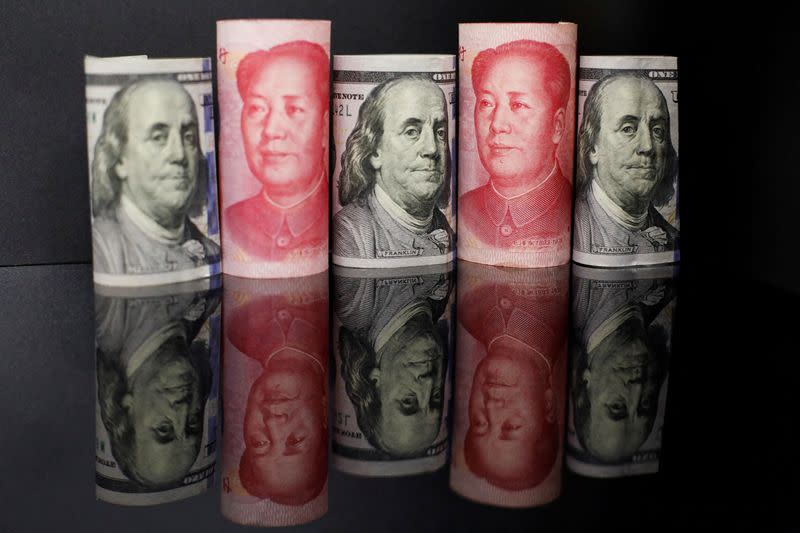China’s big state banks moved to support the yuan on Monday, when the sell-off of Chinese stocks continued.
Sources said the banks were actively selling US dollars onshore while the Shanghai Composite Index fell by 2.7% – its biggest one-day fall since April 2022.
The aim was to tighten liquidity in the offshore foreign exchange market – to prevent the yuan from falling too fast as China’s A shares plunged, one source told Reuters. The Hang Seng Index in Hong Kong also fell by about 2.3%.
ALSO SEE: OpenAI’s Altman Seeking Billions for AI Chip Venture – FT
“It is a clear policy signal to stabilise the yuan and counter the negative market sentiment on equities,” Gary Ng, senior economist for Asia Pacific at Natixis, said.
Overseas funds have sold roughly $1.6 billion in Chinese equities so far this year, with investor confidence bruised by signs of a slowdown in the world’s second largest economy.
Offshore yuan tomorrow-next forwards jumped to a more than two-month high of 4.25 points late on Monday, reflecting signs of tighter liquidity conditions.
The rise come as state banks in the offshore market curtailed lending to their peers, one of the sources said.
The move effectively tightened up offshore yuan liquidity and raised the cost of shorting the currency.
Bid to Stop Rapid Yuan Decline
Meanwhile, the state banks were also selling dollars in the onshore spot foreign exchange market to prevent rapid yuan declines, three sources said.
Spot dollar selling became aggressive to defend the 7.2 per dollar level, one of them said.
All the sources spoke on condition of anonymity as they are not allowed to publicly discuss market conditions.
State banks often act on behalf of China’s central bank in the foreign exchange market, but they could also trade on their own behalf or execute clients’ orders.
The onshore yuan last traded at 7.1963 per dollar, down nearly 1.4% so far this year, while its offshore counterpart last fetched 7.2047.
PBOC keeps benchmark lending rates steady
China kept benchmark lending rates unchanged at their monthly fixing on Monday, matching expectations with Beijing seen as having limited scope for monetary easing amid downward pressure on the yuan.
The decision came after the People’s Bank of China (PBOC) surprised markets last week by holding its medium-term lending facility rate steady.
The central bank has stood pat despite recent data underscoring the uneven nature of China’s economic recovery and deflationary pressures pushing up real borrowing costs.
Julian Evans-Pritchard, head of China economics at Capital Economics said policymakers “appear to harbour lingering concerns” about the yuan.
“A cut at this stage could trigger additional depreciation pressure, something the PBOC wants to avoid. Therefore, it may stick to quantitative easing tools for now,” he said, citing pledged supplementary lending as an example.
The one-year loan prime rate (LPR) was kept at 3.45%, and the five-year LPR was unchanged at 4.20%. In a Reuters poll of 27 market watchers last week, all but one participant predicted both LPRs would stay unchanged.
Most new and outstanding loans in China are based on the one-year LPR, while the five-year rate influences the pricing of mortgages.
Downward pressure on China’s yuan resurfaced in the new year, weighed down by a dollar buoyant on signs of resilience in the US economy and caution that the Federal Reserve may take longer than some had expected to cut rates.
The onshore yuan has lost about 1.3% for the year to date, hitting its weakest level in two months.
Evans-Pritchard said he expects the PBOC to resume rate cuts as soon as the yuan regains some ground, forecasting 20 basis points in rate reductions by the end of the second quarter.
The one-year LPR was cut twice last year by a total of 20 basis points, while the five-year LPR was lowered by 10 basis points.
Market watchers also expect the central bank to ramp up liquidity injections before the upcoming Lunar New Year holidays, when cash demand from corporates and households usually picks up.
The PBOC is expected to employ methods such as reverse repos in open market operations, the state-owned China Securities Journal cited analysts as saying on Monday, adding that chances of a reduction in banks’ reserve requirement ratio (RRR) could also not be ruled out.
The week-long holiday starts on February 10 this year.
- Reuters with additional editing by Jim Pollard
NOTE: This report was expanded on January 22, 2024 with text on the PBOC move to leave lending rates unchanged earlier on Monday.
ALSO SEE:
Chinese Economy is in Trouble, US Nobel Laureate Says – NYT
Debt-Laden Chinese Regions Told to Stop Some State Projects
China Saw 5.2% Growth Last Year, But 2024 Likely to be Tougher
China Not a Risk, Premier Li Tells Davos Business Leaders
























